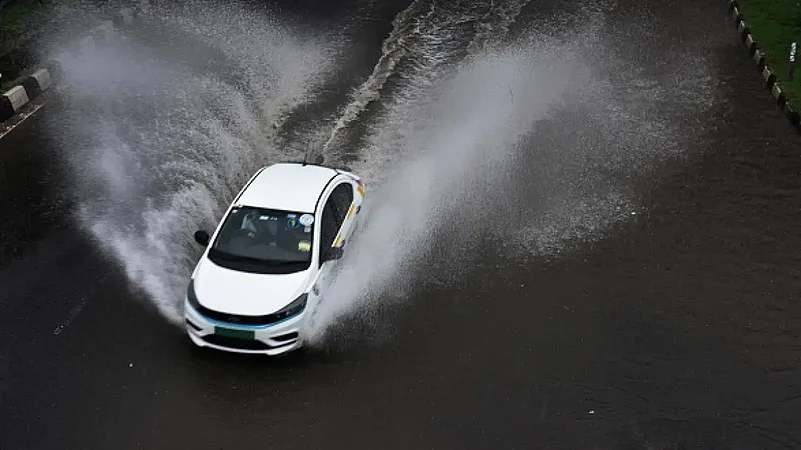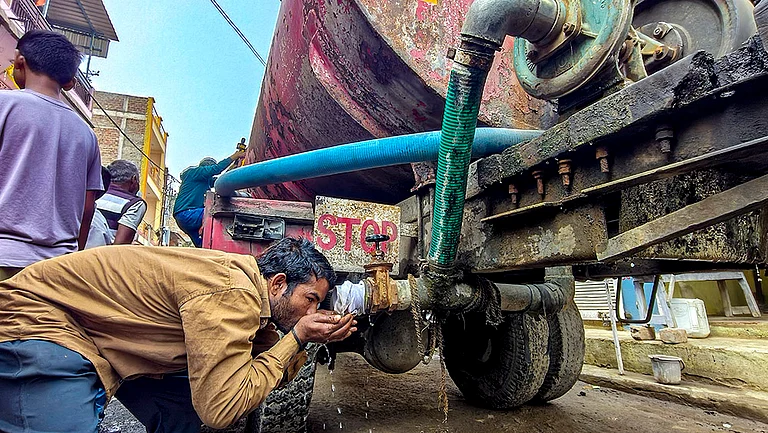India went through a huge transition when Delhi, Mumbai, Chennai, Calcutta, Bangalore, Hyderabad, and other cities became hubs for economic activities and rapid urbanisation. The ever-burgeoning urban population demanded more robust infrastructure such as roads, houses, shopping complexes, etc. And unplanned development has brought about many big challenges; one of them being urban flooding due to poor stormwater management.
Storm water is the huge amount of standing water produced after heavy rain/snow. When stormwater is absorbed by soil and filters through, it ultimately replenishes the aquifer. But due to high concretisation in many of our urban cities, this stormwater finds no direct ground to seep through. All the water gushes into storm drains, sewer systems and drainage ditches, and causes soil erosion, silting, road damage, property damage, by creating waterlogging in nearby low areas or ditches.
In recent years, frequency of urban flooding has increased and is causing enormous socio-environmental hazards, major economic loss, along with the loss of lives as in the recent cases of Hyderabad and Assam. Delhi-NCR always faces long traffic snarls during heavy rains; one such infamous incident was Gurujam in Gurugram, the millennium city bordering Delhi that came to standstill for almost 20 hours due to traffic jams after heavy rainfall.
A research paper published by Kapil Gupta from IIT-B on stormwater management in Mumbai records that the urban catchment of Kalyan, situated in North Mumbai which faces local flooding every year, political will more than engineering support to improve and that the existing stormwater drainage system requires.
The Karnataka government report of 2021 on performance audit of stormwater management in Bangalore by AG India says that the city witnessed large-scale encroachment of lakes and drains, depletion of natural drainage system, change of land use, reduced vegetation cover, and loss of interconnectivity between water bodies that increased the runoff of stormwater. It was found that of the 1,452 water bodies in the early 1800s, only 194 remained by 2016 in the same area as there is no robust policy governing stormwater management.
In the report by Centre for Science and Environment, The National Capital Territory (NCT) of Delhi is one of the largest urban spaces in the world and has a ground water table 40m below ground level in as much as 30 per cent of the city. As per the report, open spaces like parks have been identified in the city to prepare a sustainable stormwater management plan, keeping in mind factors such as post monsoon ground water level, geology, soil type and flood spots. The city is estimated to have 16,299 parks that have the capacity to harvest 3,423 million litres of annual runoff.
The Environmental Impact Assessment Report 2021 by Greater Chennai Corporation that has built and maintained a stormwater drain network of 2,071 km, states that rainwater runoff gets drained through various stormwater drains and channels and reaches the sea across the city. Over the period, these drains’ carrying capacity reduced due to silt deposition. All such channels require desilting, and cleaning and disposing waste materials before the monsoon arrives, which puts a lot of stress on the municipal system.
Historical records have shown several cases of extreme flooding in Chennai in 1943, 1978, 1985, 2002, 2005, and so on. Mainly all because of change in land use, disruption of natural gradient of stormwater channels, inadequacy, and imperativeness of local drainage infrastructure development in the city.
According to a report published by Centre for Science and Environment for Hyderabad — the fastest-growing urban space in India after recording an annual 5 per cent population rise, the city has suffered several flooding episodes, the latest being in 2020 where 200mm rainfall happened overnight, resulting in a fury of runoff that submerged the entire city. Over 76 people died and it caused economic damage estimated at around 1,000 crores. The cause: limited stormwater channels propelled the runoff.
Historically, Hyderabad had 400 lakes, and at least 48 flood absorbing tanks were built as part of stormwater management plan in 1912-29. Over time, most of them have been filled and used for various residential and commercial purposes. Currently, only 169 lakes exist as several water channels to carry stormwater have been encroached. Now the city’s stormwater management agenda is largely based on evacuation plans for flood-affected areas rather than storage or reuse of stormwater.
All of these questions regarding collection, storage and reuse of stormwater are answered through proper stormwater management that must be based on urban, peri-urban and rural population density. Rapid urbanisation didn’t incorporate sustainable infrastructure plans. Unplanned or illegal land acquisition has led to encroachment of several kilometres of natural stormwater channels in such urban cities.
Several water bodies like lakes, ponds, wells, etc., have been filled to fulfil various economic interests that essentially acted as runoff collectors. Most of our urban cities are concretised and are left with almost no space for rainwater absorption. Either stormwater drainage is missing in many such places, even if it’s there, most of the time it’s clogged with solid waste, silt, etc. To make the situation worse, many such channels are even connected with sewer pipelines. Even after mandatory rainwater harvesting system installation by group housing societies as per building code law, it’s not built or are used for different purposes or may even be symbolic and defunct.
Quality of recharge water is also of huge concern and eventually such runoff mixed with mud and several chemicals and sewage finds its way to the nearby water body and over the period turns it into a ganda nalla (a dirty water channel). Most of the urban road system consisting of flyovers, underpasses and artery roads are not built with keeping runoff in mind. Every monsoon these low-lying areas get flooded after just one spell of heavy rainfall. Many such flooding hotspots like Delhi’s Minto Bridge make news every monsoon for getting submerged under storm water.
Stormwater is not a liability to manage, rather a resource to conserve. As per a report, water demand in irrigation, domestic and industrial uses and other usage will be more than 1,000 cubic kilometres by 2025. If 80 per cent rainwater can be harvested by 2015, almost 33 per cent of such water requirements can be met with rainwater conservation. Not to mention the presence of other water resources. Sustainable urban designing would require rejuvenation of water bodies to increase their water holding and recharge capacity, increasing green cover in such areas by planting more trees, reviving old water storages, and creating awareness and willingness among stakeholders to save water.
We must also consider the global contribution of climate change. Over the period, it has changed the rain pattern and caused unprecedented rainfall. Most of the urban infrastructure is not equipped to handle such eventualities, hence risk and vulnerability assessment is essential for urban stormwater management planning. For instance, stormwater drainage design in India was being carried out as per the Central Public Health and Environmental Engineering Organization (CPHEEO) manual guidelines, but only till 2019. Another part of the manual is guidelines for operation and maintenance. It’s important to note that having stormwater drainage channels but without regular and proper maintenance doesn’t serve the purpose.
As per the report of the Sub-committee for Development of National Sustainable Habitat Parameters on Urban Storm water Management by the Ministry of Housing and Urban Affairs, it has been suggested that the various indices developed for assessment of drainage systems can be utilised for quantification of the sustainability of current drainage systems. After quantification, these indices will help to determine suitable drainage practices in specific wards, blocks, districts, or states, and finally the country. Such measures can be integrated in restoring the natural drainage system, rejuvenating lakes and ponds, and catchment areas, and thereby creating a sustainable stormwater management plan.
It’s important to reiterate that stormwater is not a liability to manage, but a resource to conserve. Sustainable urban planning, innovative design solutions, right policies, strong stakeholder participation, awareness at large, and strong political will, can decrease water stress that most of our urban cities are currently facing. A holistic water security plan is the need of the hour.
(The writer is an environmentalist with more than a decade of experience. Views expressed are personal)





















